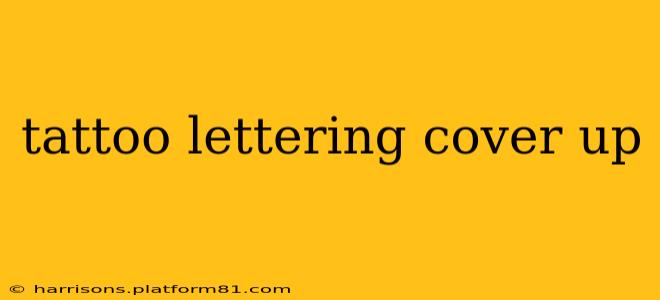Getting a tattoo is a deeply personal decision, a form of self-expression etched onto your skin. But sometimes, the passage of time, a change in personal style, or simply regret can lead to the desire for a tattoo cover-up. This guide focuses specifically on covering up existing lettering tattoos, a challenge unique due to the linear and often intricate nature of the design. We'll explore various techniques, design considerations, and the crucial aspects of choosing the right artist for a successful cover-up.
What are the best ways to cover up lettering tattoos?
Covering lettering tattoos effectively depends heavily on several factors: the size, style, and color of the original lettering; the desired new tattoo design; and the skill of the tattoo artist. Larger, bolder lettering is generally easier to cover than smaller, fine-line script. Darker inks are more challenging to conceal than lighter ones.
Successful cover-ups often involve strategically incorporating the existing lines and shapes into a new design. For instance, a sprawling floral design can beautifully camouflage straight lines, while a more abstract design can cleverly incorporate the existing lettering into its overall composition. A skilled artist can use shading and color to blend the old tattoo into the new design, making it virtually invisible.
What designs are best for covering up lettering tattoos?
The best designs for covering lettering tattoos are often those that are bold, detailed, and visually complex. These designs effectively obscure the old lettering while creating a stunning new piece of art. Some popular choices include:
- Large-scale floral designs: Flowers with intricate petals and leaves offer a beautiful and versatile option, effectively masking straight lines.
- Mandala designs: The intricate geometric patterns of mandalas can seamlessly incorporate and camouflage existing lettering.
- Abstract designs: Abstract art provides immense freedom for creativity, allowing the artist to strategically place elements to conceal the old tattoo.
- Animal portraits: Detailed animal portraits, especially those with rich textures and shading, are an excellent choice for covering larger areas of lettering.
- Geometric patterns: Bold geometric shapes and patterns can be exceptionally effective in disguising the lines of old lettering.
How much does it cost to cover up lettering tattoos?
The cost of a lettering tattoo cover-up varies significantly depending on several factors, including the size of the area to be covered, the complexity of the new design, the experience of the tattoo artist, and the location of the tattoo studio. Expect to pay a higher price for larger, more intricate cover-ups done by experienced artists. It's best to consult with several artists for personalized quotes before making a decision. Don't hesitate to discuss your budget openly with the artist; they can help you find a design that fits your aesthetic preferences and financial constraints.
How to choose a tattoo artist for a cover-up?
Choosing the right artist for a lettering tattoo cover-up is paramount. It’s crucial to find an artist with extensive experience in cover-ups, particularly those involving lettering. Look for an artist with a strong portfolio showcasing successful cover-up work. Their understanding of color theory and the ability to strategically incorporate the old tattoo into the new design are critical for a successful outcome.
Consider these factors when choosing an artist:
- Review their portfolio: Look for examples of similar cover-up projects, especially those involving lettering.
- Consult multiple artists: Get several consultations to compare styles, pricing, and artistic visions.
- Read reviews: Check online reviews to gauge client experiences and the artist's professionalism.
- Discuss your vision: Clearly communicate your expectations and preferences with the artist.
Can you cover up lettering with another small tattoo?
While it's possible to try and cover up lettering with another small tattoo, it's often not the ideal solution. This is particularly true for smaller, intricate lettering, where the original lines might still show through or create an undesirable, cluttered effect. Unless the new tattoo is significantly larger and more complex than the lettering it aims to cover, it's unlikely to produce a successful and aesthetically pleasing result. Larger, bolder designs are generally more effective for covering lettering.
What is the best color to cover up dark lettering?
There isn't one single "best" color for covering dark lettering. The most effective color depends on the specific dark ink of the original lettering and the desired design of the new tattoo. A skilled artist will utilize a range of colors, strategically placed and blended to effectively mask the dark ink. Often, darker shades in the new design can help to better conceal the old tattoo. However, the overall design and color scheme should complement the new artwork, not simply focus on concealing the old one.
How long does it take to cover up a lettering tattoo?
The time required for a lettering tattoo cover-up depends on the size and complexity of both the original tattoo and the new design. Smaller, simpler cover-ups may take a few hours, while larger, more intricate designs can take multiple sessions spread over several weeks or months. The artist will provide a more accurate estimate after a consultation.
By carefully considering these factors and choosing a skilled artist, you can achieve a beautiful and successful tattoo cover-up that transforms an unwanted tattoo into a stunning piece of body art. Remember, patience and thorough planning are key to a successful outcome.
